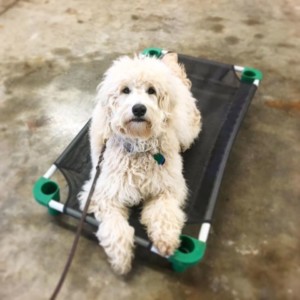Car sickness is no fun for anyone—especially your dog. Whether you simply want to be able to get to the vet without your dog throwing up in the car or you want to be able to take your canine pal on road trips with you, finding ways to treat car sickness will help alleviate both your worry and your dog’s discomfort.
What can cause this:
Motion Sickness
Just as many children (and some adults) suffer from motion sickness, your dog can have a negative experience from your vehicles actual motion. The landmarks buzzing by and the wind pounding against the windows can certainly cause a dog to be thrown off balance and be the basis for this. It’s also important to keep in mind that with younger puppies, their ear structure which helps them stay balanced has not fully developed yet. It can be even easier for a puppy to become sick from the motion versus an older dog.
Anxiety
If as a puppy, your dog threw up in your car, they may always look at the car as a scary place. Anxiety can also come from the places that you take your dog if you’re limiting them to just locations that they may already be nervous about, like the vet.
Here’s what to do:
1. Makeover your dog’s understanding of the car.
If you only ever put your dog in the car to go to the vet, they will probably have anxiety every time they even see a car. Start finding other opportunities to put your dogs in the car, like taking them to the park or to the pet store to get a treat.
2. Ride on an empty stomach.
Don’t feed your dog or let them have anything to drink before getting in the car. If you are going on a long ride, don’t let them have anything to eat for about six hours before the drive. Let them have water, but nothing solid. This can often help many dogs that experience motion sickness.
3. Stop frequently.
 If you are going on a long trip, make sure to plan in time to stop frequently. Getting out of the car and stretching your legs can alleviate your own motion sickness and it can be just as beneficial for your dog. Especially if you start to notice that they are drooling and panting, pull over and let them out of the car for a nice walk or run.
If you are going on a long trip, make sure to plan in time to stop frequently. Getting out of the car and stretching your legs can alleviate your own motion sickness and it can be just as beneficial for your dog. Especially if you start to notice that they are drooling and panting, pull over and let them out of the car for a nice walk or run.
4. Provide distractions.
Having an additional person in the car who can distract your dog with a toy is a great way to combat car sickness. They’ll be so focused on having fun, they won’t have any anxiety about the car ride!
5. Work Your Way into Car Rides.
Respected dog trainer Cesar Millan suggests slowly getting your dog comfortable with approaching the car. Then, get them comfortable with getting into the car and sitting in the back with the engine off. These slow stages are a great way to change your dog’s perception of the experience they will have when riding in the car.
In many cases, one of these techniques will likely do the trick to help your dog feel more comfortable and less anxious. Riding in the car should be a fun and enjoyable experience for your dog who spends most of his or her days in the same surroundings.
Note: You can buy special harnesses to be used for seat belts, but it’s safer to have your dog in the back seat versus the front. Airbags in cars can be very dangerous for a dog, so it’s something to keep in mind when deciding how your dog will ride along with you.
I hope it helps, and you and your pooch can enjoy lots of great road trips together!




